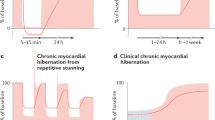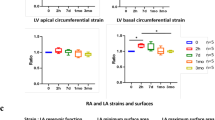Abstract
Stress cardiomyopathy, also referred to as Takotsubo cardiomyopathy, is an increasingly recognized clinical syndrome characterized by acute reversible apical ventricular dysfunction. We hypothesize that stress cardiomyopathy is a form of myocardial stunning, but with different cellular mechanisms to those seen during transient episodes of ischemia secondary to coronary stenoses. In this syndrome, we believe that high levels of circulating epinephrine trigger a switch in intracellular signal trafficking in ventricular cardiomyocytes, from Gs protein to Gi protein signaling via the β2-adrenoceptor. Although this switch to β2-adrenoceptor–Gi protein signaling protects against the proapoptotic effects of intense activation of β1-adrenoceptors, it is also negatively inotropic. This effect is greatest at the apical myocardium, in which the β-adrenoceptor density is greatest. Our hypothesis has implications for the use of drugs or devices in the treatment of patients with stress cardiomyopathy.
Key Points
-
Stress cardiomyopathy is the result of the direct effects of high levels of epinephrine on the ventricular myocardium
-
High levels of epinephrine are negatively inotropic; they switch β2-adrenoceptor coupling in ventricular cardiomyocytes, from the Gs protein to the Gi protein signaling pathway
-
The density of β-adrenoceptors is greatest at the apical myocardium of the mammalian heart, which explains the regional nature of the stunning in response to high levels of circulating epinephrine after stressful stimuli
-
This effect is reversible after the epinephrine levels return to normal, which explains why left ventricular function and apical wall motion return to normal within days to weeks of the acute insult
This is a preview of subscription content, access via your institution
Access options
Subscribe to this journal
Receive 12 print issues and online access
$209.00 per year
only $17.42 per issue
Buy this article
- Purchase on Springer Link
- Instant access to full article PDF
Prices may be subject to local taxes which are calculated during checkout



Similar content being viewed by others
References
Satoh H et al. (1990) Takotsubo-type cardiomyopathy due to multivessel spasm. In Clinical Aspect of Myocardial Injury: From Ischemia to Heart Failure, 56–64 (Eds Kodama K. et al.) Tokyo: Kagakuhyouronsya Co.
Akashi YJ et al. (2003) The clinical features of takotsubo cardiomyopathy. QJM 96: 563–573
Akashi YJ et al. (2005) Reversible ventricular dysfunction takotsubo cardiomyopathy. Eur J Heart Fail 7: 1171–1176
Sharkey SW et al. (2005) Acute and reversible cardiomyopathy provoked by stress in women from the United States. Circulation 111: 472–479
Gianni M et al. (2006) Apical ballooning syndrome or takotsubo cardiomyopathy: a systematic review. Eur Heart J 27: 1523–1529
Maron BJ et al. (2006) Contemporary definitions and classification of the cardiomyopathies: an American Heart Association Scientific Statement from the Council on Clinical Cardiology, Heart Failure and Transplantation Committee; Quality of Care and Outcomes Research and Functional Genomics and Translational Biology Interdisciplinary Working Groups; and Council on Epidemiology and Prevention. Circulation 113: 1807–1816
Yamabe H et al. (1996) Deep negative T waves and abnormal cardiac sympathetic image (123I-MIBG) after the great hanshin earthquake of 1995. Am J Med Sci 311: 221–224
Watanabe H et al. (2005) Impact of earthquakes on takotsubo cardiomyopathy. JAMA 294: 305–307
Jensen JB and Malouf JF (2006) Takotsubo cardiomyopathy following cholecystectomy: a poorly recognized cause of acute reversible left ventricular dysfunction. Int J Cardiol 106: 390–391
Berman M et al. (2007) Takotsubo cardiomyopathy: expanding the differential diagnosis in cardiothoracic surgery. Ann Thorac Surg 83: 295–298
Akashi YJ et al. (2002) Reversible left ventricular dysfunction “takotsubo” cardiomyopathy associated with pneumothorax. Heart 87: E1
Arai M et al. (2004) A case of transient left ventricular ballooning (“Takotsubo”-shaped cardiomyopathy) developed during plasmapheresis for treatment of myasthenic crisis [Japanese]. Rinsho Shinkeigaku 44: 207–210
Maruyama S et al. (2006) Suspected takotsubo cardiomyopathy caused by withdrawal of bupirenorphine in a child. Circ J 70: 509–511
Saito Y (2005) Hypoglycemic attack: a rare triggering factor for takotsubo cardiomyopathy. Intern Med 44: 171–172
Suzuki K et al. (2004) An atypical case of “Takotsubo cardiomyopathy” during alcohol withdrawal: abnormality in the transient left ventricular wall motion and a remarkable elevation in the ST segment. Intern Med 43: 300–305
Wittstein IS et al. (2005) Neurohumoral features of myocardial stunning due to sudden emotional stress. N Engl J Med 352: 539–548
Goldstein DS et al. (2003) Sources and significance of plasma levels of catechols and their metabolites in humans. J Pharmacol Exp Ther 305: 800–811
Ferreira SH and Vane JR (1967) Half-lives of peptides and amines in the circulation. Nature 215: 1237–1240
Tung P et al. (2004) Predictors of neurocardiogenic injury after subarachnoid hemorrhage. Stroke 35: 548–551
Kono T et al. (1994) Left ventricular wall motion abnormalities in patients with subarachnoid hemorrhage: neurogenic stunned myocardium. J Am Coll Cardiol 24: 636–640
Davies K et al. (1991) Cardiac function in aneurysmal subarachnoid haemorrhage: a study of electrocardiographic and echocardiographic abnormalities. Br J Anaesth 67: 58–63
Ennezat PV et al. (2005) Transient left ventricular basal dysfunction without coronary stenosis in acute cerebral disorders: a novel heart syndrome (inverted Takotsubo). Echocardiography 22: 599–602
Doshi R and Neil-Dwyer G (1977) Hypothalamic and myocardial lesions after subarachnoid haemorrhage. J Neurol Neurosurg Psychiatry 40: 821–826
Takizawa M et al. (2007) A case of transient left ventricular ballooning with pheochromocytoma, supporting pathogenetic role of catecholamines in stress-induced cardiomyopathy or takotsubo cardiomyopathy. Int J Cardiol 114: E15–E17
Sanchez-Recalde A et al. (2006) Images in cardiovascular medicine: pheochromocytoma-related cardiomyopathy: inverted Takotsubo contractile pattern. Circulation 113: e738–e739
Port JD and Bristow MR (2001) Altered Beta-adrenergic receptor gene regulation and signalling in chronic heart failure. J Mol Cell Cardiol 33: 887–905
Zhu WZ et al. (2001) Dual modulation of cell survival and cell death by beta(2)-adrenergic signaling in adult mouse cardiac myocytes. Proc Natl Acad Sci USA 98: 1607–1612
Heubach JF and Kaumann AJ (2004) Epinephrine activates both Gs and Gi pathways, but norepinephrine activates only the Gs pathway through human beta2-adrenoceptors overexpressed in mouse heart. Mol Pharmacol 65: 1313–1322
Heubach JF et al. (2003) Cardiostimulant and cardiodepressant effects through overexpressed human β2-adrenoceptors in murine heart. Naunyn Schmiedebergs Arch Pharmacol 367: 380–390
Daaka Y et al. (1997) Switching of the coupling of the beta2-adrenergic receptor to different G proteins by protein kinase A. Nature 390: 88–91
Zamah AM et al. (2002) Protein kinase A-mediated phosphorylation of the beta 2-adrenergic receptor regulates its coupling to Gs and Gi: demonstration in a reconstituted system. J Biol Chem 277: 31249–31256
Kilts JD et al. (2000) Beta(2)-adrenergic and several other G protein-coupled receptors in human atrial membranes activate both G(s) and G(i). Circ Res 87: 705–709
Brown LA and Harding SE (1992) The effect of pertussis toxin on β-adrenoceptor responses in isolated cardiac myocytes from noradrenaline-treated guinea-pigs and patients with cardiac failure. Br J Pharmacol 106: 115–122
Gong H et al. (2002) The specific β2AR blocker, ICI 118,551, actively decreases contraction through a Gi-coupled form of the β2AR in myocytes from failing human heart. Circulation 105: 2497–2503
Feldman AM et al. (1988) Increase of the 40,000-mol wt pertussis toxin substrate (G protein) in the failing human heart. J Clin Invest 82: 189–197
Zheng Z et al. (2004) Acute negative inotropic effect of beta2-AR blockers through p38-MAPK signaling pathway in human ventricular myocytes [abstract #C119]. J Mol Cell Cardiol 37: a297
Liao P et al. (2001) p38 Mitogen-activated protein kinase mediates a negative inotropic effect in cardiac myocytes. Circ Res 90: 190–196
Peter PS et al. (2007) Inhibition of p38alpha MAPK rescues cardiomyopathy induced by overexpressed beta(2)-adrenergic receptor, but not beta(1)-adrenergic receptor. J Clin Invest 117: 1335–1343
Zheng Z et al. (2005) Interaction of Na+/Ca2+ exchanger with B2Ar/Gi pathway in rat ventricular myocytes [abstract #238]. J Mol Cell Cardiol 38: a1084
He JQ et al. (2005) Crosstalk of beta-adrenergic receptor subtypes through Gi blunts beta-adrenergic stimulation of L-type Ca2+ channels in canine heart failure. Circ Res 97: 566–573
Chesley A et al. (2000) The beta(2)-adrenergic receptor delivers an antiapoptotic signal to cardiac myocytes through G(i)-dependent coupling to phosphatidylinositol 3′-kinase. Circ Res 87: 1172–1179
Communal C et al. (1999) Opposing effects of beta(1)- and beta(2)-adrenergic receptors on cardiac myocyte apoptosis: role of a pertussis toxin-sensitive G protein. Circulation 100: 2210–2212
Kawano H et al. (2003) Histological study on the distribution of autonomic nerves in the human heart. Heart Vessels 18: 32–39
Mori H et al. (1993) Increased responsiveness of left ventricular apical myocardium to adrenergic stimuli. Cardiovasc Res 27: 192–198
Rona G (1985) Catecholamine cardiotoxicity. J Mol Cell Cardiol 17: 291–306
Brouri F et al. (2004) Blockade of β1- and desensitization of β2-adrenoceptors reduce isoprenaline-induced cardiac fibrosis. Eur J Pharmacol 485: 227–234
Kurisu S et al. (2002) Tako-tsubo-like left ventricular dysfunction with ST-segment elevation: a novel cardiac syndrome mimicking acute myocardial infarction. Am Heart J 143: 448–455
Abe Y et al. (2003) Assessment of clinical features in transient left ventricular apical ballooning. J Am Coll Cardiol 41: 737–742
Davidson L et al. (1984) Sex-related differences in resting and stimulated plasma noradrenaline and adrenaline. Clin Sci (Lond) 67: 347–352
Ling S et al. (2006) Cellular mechanisms underlying the cardiovascular actions of oestrogens. Clin Sci (Lond) 111: 107–118
Patten RD et al. (2004) 17β-estradiol reduces cardiomyocyte apoptosis in vivo and in vitro via activation of phospho-inositide-3 kinase/akt signaling. Circ Res 95: 692–699
Ueyama T et al. (1999) Emotional stress induces immediate-early gene expression in rat heart via activation of alpha- and beta-adrenoceptors. Am J Physiol 277: H1553–H1561
Ueyama T et al. (2003) Molecular mechanism of emotional stress-induced and catecholamine-induced heart attack. J Cardiovasc Pharmacol 41 (Suppl 1): S115–S118
Ueyama T et al. (2007) Chronic estrogen supplementation following ovariectomy improves the emotional stress-induced cardiovascular responses by indirect action on the nervous system and by direct action on the heart. Circ J 71: 565–573
Kam KWL et al. (2004) Estrogen reduces cardiac injury and expression of β1-adrenoceptor upon ischemic insult in the rat heart. J Pharmacol Exp Ther 309: 8–15
Chu SH et al. (2006) Effect of estrogen on calcium-handling proteins, β-adrenergic receptors, and function in rat heart. Life Sci 79: 1257–1267
Kneale BJ et al. (2000) Gender differences in sensitivity to adrenergic agonists of forearm resistance vasculature. J Am Coll Cardiol 36: 1233–1238
Copetti R et al. (2007) “Inverted Takotsubo” pattern. Resuscitation 74: 394
Van de Walle SO et al. (2006) Transient stress-induced cardiomyopathy with an “inverted takotsubo” contractile pattern. Mayo Clin Proc 81: 1499–1502
Kuroko Y et al. (2007) Cardiac epinephrine synthesis and ischemia-induced myocardial epinephrine release. Cardiovasc Res 74: 438–444
Choudhury L et al. (1996) Myocardial beta adrenoceptors and left ventricular function in hypertrophic cardiomyopathy. Heart 75: 50–54
Hein TW et al. (2004) Heterogeneous β2-adrenoceptor expression and dilation in coronary arterioles across the left ventricular wall. Circulation 110: 2708–2712
Turner NA et al. (2003) Chronic β2-adrenergic receptor stimulation increases proliferation of human cardiac fibroblasts via an autocrine mechanism. Cardiovasc Res 57: 784–792
Harding SE and Gong H (2004) β-adrenoceptor blockers as agonists: coupling of β2-adrenoceptors to multiple G-proteins in failing human heart. Congest Heart Fail 10: 181–187
Acknowledgements
Désirée Lie, University of California, Irvine, CA, is the author of and is solely responsible for the content of the learning objectives, questions and answers of the Medscape-accredited continuing medical education activity associated with this article.
Author information
Authors and Affiliations
Corresponding author
Ethics declarations
Competing interests
The authors declare no competing financial interests.
Supplementary information
Rights and permissions
About this article
Cite this article
Lyon, A., Rees, P., Prasad, S. et al. Stress (Takotsubo) cardiomyopathy—a novel pathophysiological hypothesis to explain catecholamine-induced acute myocardial stunning. Nat Rev Cardiol 5, 22–29 (2008). https://doi.org/10.1038/ncpcardio1066
Received:
Accepted:
Issue Date:
DOI: https://doi.org/10.1038/ncpcardio1066
This article is cited by
-
Angiotensin 1–7 in an experimental septic shock model
Critical Care (2023)
-
Takotsubo pathophysiology and complications: what we know and what we do not know
Heart Failure Reviews (2023)
-
Myocardial effects of angiotensin II compared to norepinephrine in an animal model of septic shock
Critical Care (2022)
-
Autoimmune polyendocrine syndrome II presenting paradoxically as Takotsubo cardiomyopathy: a case report and reappraisal of pathophysiology
The Egyptian Heart Journal (2022)
-
Duchenne muscular dystrophy patients: troponin leak in asymptomatic and implications for drug toxicity studies
Pediatric Research (2022)



